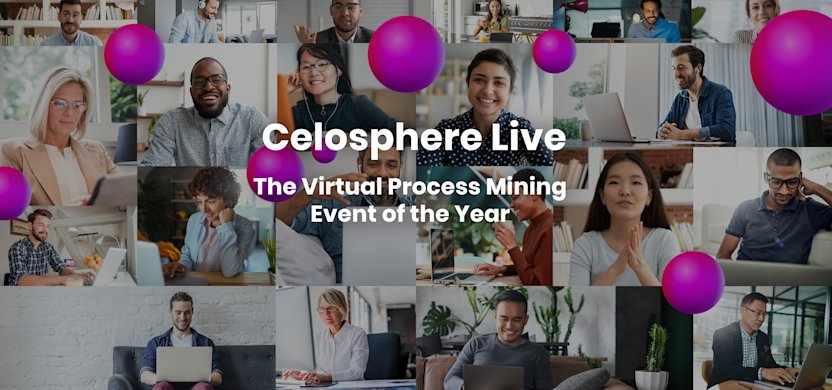
Process Mining in Action: 11 Takeaways from Lars Reinkemeyer
Process Mining is currently one of the hottest topics in the business world. Companies like Siemens, Lufthansa or BMW use the technology to turn their processes (once just a construct designed on paper), into an open book. By creating an X-ray of their business operations, the technology provides the much-needed insights to eliminate bottlenecks, drive transformation and achieve better business results.
But how do you get started with Process Mining? What are the most promising use cases? And what challenges do you need to be ready to tackle when deploying and scaling up Process Mining across departments?
All questions that Lars Reinkemeyer, one of the leading minds in Process Mining, answers in his new book Process Mining in Action.
Exchange is one of the secrets behind Process Mining
The former head of Process Mining at Siemens and now Guest Lecturer at UCSB & Stanford GSB talked to Process Mining evangelists at companies like BMW, Bosch, Siemens, Bayer, and Uber. Giving not only an overview of success stories across industries, but also tackling the challenges Process Mining practitioners faced, this book is one of the first practical Process Mining guides written by practitioners for practitioners.
Lars Reinkemeyer will be one of the thought leaders speaking at Celosphere Live, the world’s number one virtual Process Mining event held by Celonis. At the event, he will talk about principles and key learnings and provide an overview of successful use cases.

We took the time to ask Lars Reinkemeyer about this book, why Process Mining is a key tool for successful business transformation, and where both companies and the technology will go next.
1. Process Mining has become one of the IT industry's hot topics. You wrote an entire book about it. How widely would you say the technique is being applied today?
Process Mining has seen a tremendous spike during the last couple of years. Invented by Wil van der Aalst late last millennium, it has become a rapidly growing and widely spread topic in academic research and teaching. In the corporate environment, this innovative technology has been continuously optimized for operational requirements and has seen a steep growth during the last 10 years.
Today, awareness about the impact of Process Mining is particularly high in Europe, with a large number of companies applying it in single use cases, some of them even applying it with multiple use cases across their whole value chain. The book provides an overview how it is applied across different industries, countries and operational functions.
2. What was the main motivation for you to write Process Mining in Action?
I think an open knowledge exchange between early adopters and software vendors is beneficial for all parties. It is this exchange that has allowed for turning this emerging technology into valuable tools for operational business. I wanted to further foster knowledge about the topic, exchange experiences from proven use cases and stimulate an open discussion about future potentials of Process Mining.
The more people get involved in this exchange, the more use cases and innovations we will see. And the book provides a great stage for the corporate evangelists, who drive the topic in their respective organizations.
3. I imagine it can be hard to get those people to talk openly about challenges and their solutions. How did you get them on board?
Luckily, several of the contributors had already previously been involved in regular exchanges to share use cases and experiences, and also to discuss industry requirements for software development. All of the contributors share this spirit of mutual benefit, resulting from an open exchange and deserve a great acknowledgement for getting on board.
But yes, there have also been a couple of companies, where evangelists wanted to contribute exciting use cases, but were held back by corporate restrictions.
4. If you had to decide for one main take away from your conversations with so many companies, what would that be?
During all the talks I enjoyed the spirit of open knowledge sharing and collaboration. Some of the contributors are true innovators, applying a new technology in a very particular and challenging environment. I am very grateful that they so openly shared their cases, experiences, challenges and even failures.
5. Celonis will hold our first-ever virtual Process Mining conference in April. Why do you think businesses who are on their Journey to Process Excellence should attend?
Everybody who is interested in understanding how technology can support Process Excellence and digital transformation should attend these kinds of events. And in the current situation, I believe this can be more inspirational than ever.
Use cases and benefits of Process Mining

6. Let’s give our readers some use cases. In which ways can Process Mining help companies achieve their goals throughout the value chain?
Digital Transformation is a key driver for today’s business. Transparency is a prerequisite, which can be achieved with Process Mining. Understanding actual processes in sales, manufacturing, procurement etc. allows for sustainable efficiency improvement, driving transformation and creating value. The use cases presented in the book represent some exciting examples for impact across the value chain.
Uber achieved more than $20M productivity increase through simplification, standardization and faster processing of customer inquiries.
Similarly, Telekom could save more than €50M in their shared services center with process and quality improvements.
Siemens improved the customer order handling process by reducing 10 million manual activities and achieved savings of up to 30 minutes in the handling of single purchase orders.
All these samples and more are discussed in much more detail in the respective use cases of the book.
7. What makes Process Mining one of the key tools for businesses to achieve Business Transformation?
Business Transformation is a topic widely discussed, but many programs face a key challenge: how do you manage what you can’t measure? Process Mining essentially provides an X-ray of the organization and provides full transparency on current process efficiency, areas where improvement is required and allows to identify potentials for automation and continuously track progress.
8. One of the main challenges when it comes to Business Transformation is to break down departmental silos. How can Process Mining help?
Leveraging today’s power of big data, unbiased insights can be provided for all levels of an organization. Joint definitions of actions and progress tracking becomes possible based on one single source of truth and helps to break down organizational silos. Applying this digital technology enables organizations to transform their operations towards digital optimization.
Where will Process Mining go next?

9. How has Process Mining advanced in the last couple of years? What are some of the trends you're seeing?
The first years of our journey had been focused on finding the right use cases. A great technology can’t yield any value, if you don’t apply it for the right purpose. So we worked intensely with the process experts from logistics, procurement, sales etc to understand their challenges and adopt the technology accordingly. Once we provided them with insights, we recognized that this is good, but not good enough.
So what was the next step?
Operational Business requires insights, which can be turned immediately into action. So we developed use cases and reports, which allowed the users to derive immediate actions, leading to process improvements. Besides this continuous adoption to business requirements, there is obviously the technological side. The volume of processed data has exploded. Cloud processing offers a range of benefits. IoT Platforms will fuel new business models and forms of interaction for Process Mining. And the applications are becoming more “intelligent”.
10. Speaking of future trends, where do you think Process Mining will go in the future?
While there are many buzzwords around such as AI, ML, Cognitive Intelligence etc. I would like to look at this question from a customer perspective: Process Mining has proven valuable in providing actionable insights. But today, we are still spending way too much time in finding the right event logs and actions.
Identifying the right data sources still turns out to be the main effort driver and I expect this to change by smarter data extraction and data preparation. The way how people work with the applications will change: today the user has to apply human intelligence to interpret the data and derive appropriate actions.
11. And from a vendor perspective? Where do you see Process Mining tools going next?
In the future, I expect intelligent tools, which will proactively alert users and can derive or even initiate actions independently. And I expect that tools for digitization such as Process Mining, RPA, BPM and Task Mining will merge into one concise solution. This will help companies to transform towards a digital enabled organization, a concept which is described in the outlook of my book.
Thank you, Lars.
About Lars Reinkemeyer: Before taking a sabbatical at the University of California, Santa Barbara, Lars Reinkemeyer was head of Process Mining for Siemens. Over the course of six years, he helped the organization save tens of millions in euros by improving supplier payments to achieve discounts and streamlining the company's order-to-pay process.





